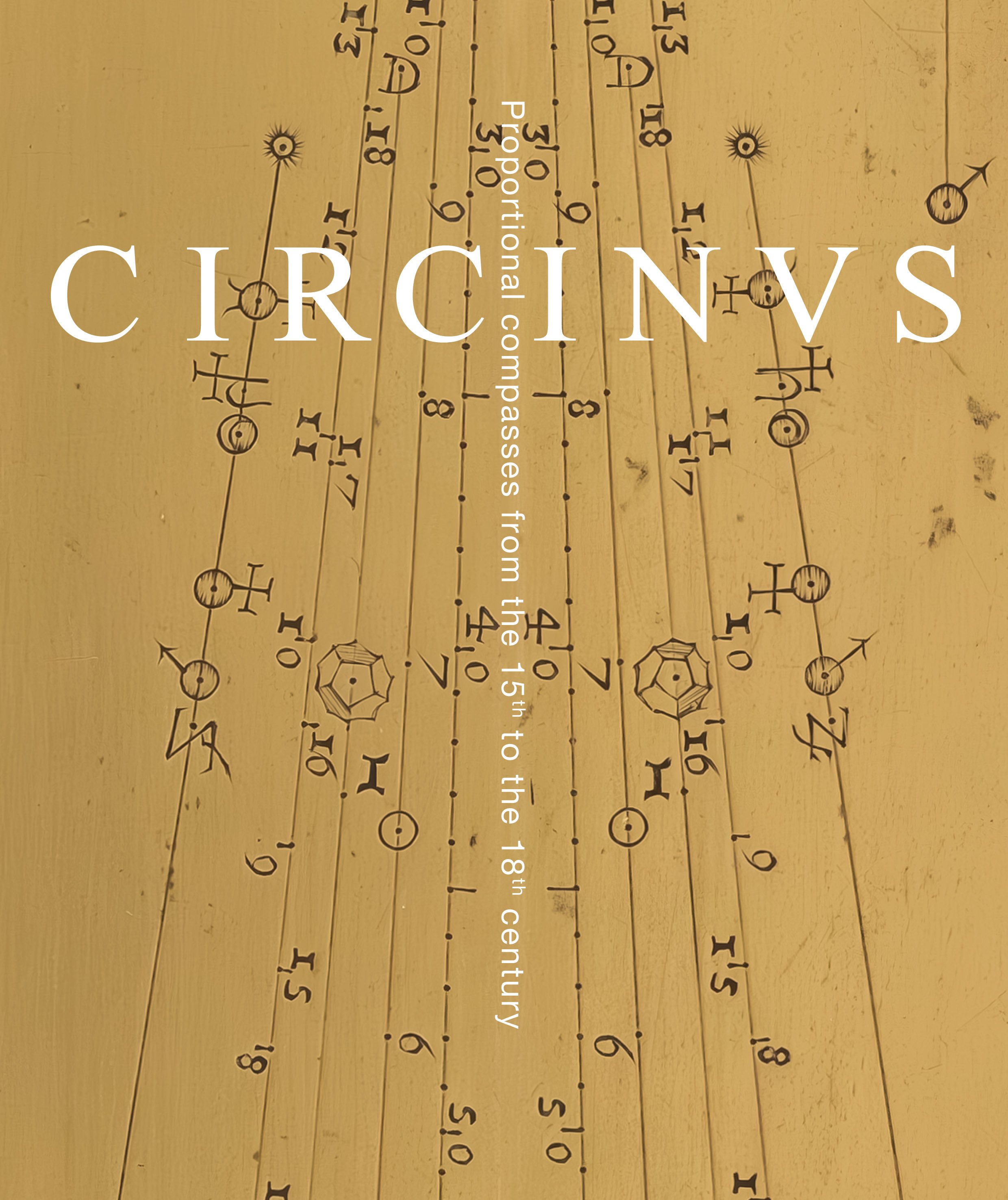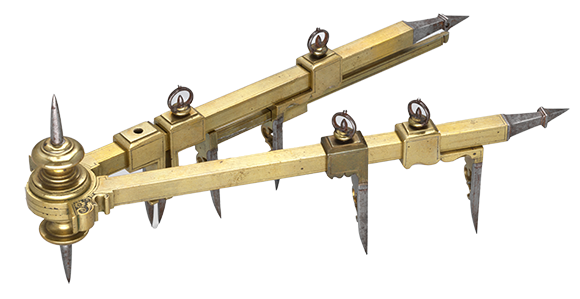Museo Galileo
CIRCINUS
For over two centuries the proportional compass was an indispensable companion for architects, engineers, and scientists. At a quick glance, the tool is a simple calculator made of two flat legs joined by a hinge. Each leg is incised with diverse scales providing for measurements, calculations, and determining information of various types.
This exhibition reconstructs the history of this extraordinary instrument, which stands as one of the most significant achievements of Western practical mathematics. The display illustrates the compass’s evolution, functioning, and many uses, above all the fundamental role it played in the development of applied mathematics.


The proportional compass is also a perfect example of the symbiosis between science and art, fruit of the combination of rigorous mathematical principles with the virtuosity of skilled craftsmen. The precious exemplars on view are works of art in themselves, due to the richness of the materials used and the ingenuity with which each compass was designed and built.
Circinus is an adaptation of the exhibition, Proportionalzirkel und seltene Mathematik- und Zeicheninstrumente des 17. und 18. Jahrhunderts, mounted in Bonn at the Arithmeum from October 21, 2023, to June 9, 2024.
The Florentine edition, created in collaboration with the Arithmeum, is enriched with a specially designed section dedicated to the origins of the proportional compass from Leonardo da Vinci to Galileo Galilei, and features instruments and texts from the Museo Galileo collection.
original instruments
Hundreds of historic pieces are on display, coming from the Bonn Arithmeum, the Hessen Kassel Heritage, the Rocca Collection in Bonn, the Delalande Collection in Paris, the Fondazione Pisa, and the Museo Galileo itself, on view alongside both original and facsimile volumes and reconstructions of proportional compasses, including several conceived by Leonardo da Vinci.
Exhibition Curators: Ina Prinz, Patrick Rocca, Filippo Camerota
Scientific Committee: Ina Prinz (Director, Arithmeum), Patrick Rocca (Curator, Arithmeum), Filippo Camerota (Scientific Director, Galileo Museum), Giorgio Strano (Collection Supervisor, Galileo Museum), Martin Eberle (Director, Astronomisch-Physikalisches Kabinett, Hessen Kassel Heritage), Karsten Gaulke (Curator, Astronomisch-Physikalisches Kabinett, Hessen Kassel Heritage)
Info
Museo Galileo, Piazza dei Giudici 1, Florence
Hours:
Monday, Wednesday, Thursday, Friday, Saturday, and Sunday: 9:30 AM - 6:00 PM
Tuesday: 9:30 AM - 1:00 PM
The cost is included in the museum entrance ticket.
For information:
+39 055 265 311,
Highlights
Summa de Arithmetica Geometria Proportioni et Proportionalità
Luca Pacioli (ca. 1445-1517)
Tuscolano 1523
Florence, Museo Galileo Library, MED 2033
The second edition of Pacioli’s celebrated mathematical treatise (first ed. 1494), dedicated to Duke of Urbino Guidobaldo da Montefeltro, is a sort of encyclopedia of the Renaissance science of the abacus. Arithmetic, algebra, Euclidean geometry, and mercantile mathematics are the principle disciplines which Pacioli details in vernacular Italian for the general reader. He aimed to include the broadest possible audience among all the professions that depended on mathematical disciplines.
Ten-pointed sector (Mordente model)
Anonymous
c. 1600
Kassel, Astronomisch-Physikalisches Kabinett, Hessen Kassel Heritage, inv. 1962-4
This sector is a specimen of the so-called “Mordente model,” named after its inventor Fabrizio Mordente (1523-c. 1608). For two or three decades, this model was produced by the main makers of the time. This version of the sector did not have the desired success, as it required numerous time-consuming manipulations. It was also used for surveying and drawing.
Geometric and military compass
Galileo Galilei (1564-1642) c. 1606
Florence, Museo Galileo, inv. 3615
Replica of the original instrument, inv. 2430
The geometric and military compass marks the culmination of the diverse and ingenious 16 th -century research into compasses. Although principally destined for military operations, it proved itself precious to merchants, bankers, artisans, engineers, topographers, and astronomers as well. In 1606 Galileo published the treatise on The Operations of the Geometric and Military Compass and dedicated it to Prince Cosimo de’ Medici.
Explorer’s chest
Jacques Canivet (1714-1773)
1766-1768
Paris, Delalande Collection
It is the largest French chest with mathematical and drawing instruments from the 18 th century to have survived in its entirety. It weighs 40 kg and contains 160 instruments made of silver, steel, brass, ivory, glass, and wood, among which a large sector and a very rare “king’s foot” standard, that was used for checking the various measurements that were used in French harbours.
Sector
Jost Bürgi (1552-1632)
before 1600
Kassel, Astronomisch-Physikalisches Kabinett, Hessen Kassel Heritage, inv. APK G 67
This compass consists of two brass arms with a slot that end in steel tips. The simplest applications of this instrument are the division or multiplication, but other applications are also possible, such as the making of clock cogwheels.
Mathematical necessaire
Claude Langlois (1690-1756)
1738-1744
Bonn, Rocca Collection
The necessaire contains eight instruments: a 4-inch sector, which forms a square with a levelling scale, two protractors, and two compasses. One of the protractors is made of horn—at the time, the only material that was transparent and could be engraved without breaking. This necessaire is very representative of a mathematics set from this period.
Sector
Michel Butterfield (c. 1643-1724)
Paris 1681-1684
Kassel, Astronomisch-Physikalisches Kabinett, Hessen Kassel Heritage, inv. APK H 32
This sector made of silver can be used to form a levelling square. The instrument shows magnificent decorations on the movable arm and on the hinge. It is one of the finest specimens on display, probably made for a wealthy architect or engineer.
Miniature mathematical necessaire
Jean-Baptiste Delure (c. 1672-1736)
Paris, c. 1698
Bonn, Rocca Collection
This set with a case of black chagrin with silver nails is the smallest known necessaire. It contains six instruments: a miniature sector (with a size of 2.7 cm), two pairs of dividers, a semi-circular protractor (from a later period), a pen holder and a pencil holder.
Artillery sector
Georg Zorn (active 1609-1628)
Augsburg, 1613
Florence, Museo Galileo, inv. 2510
This instrument combines the characteristics of proportional compasses and the radio latino. The central leg ends in a ring that contained a gimbaled magnetic compass. Fitted with viewers (now missing), this instrument could be used for surveying. This sector—which was brought to Florence from Germany by Prince Mattias de‘ Medici in the first half of the 17 th century—was invented by Leonard Zubler.
In depth
The digital library is divided into different thematic sections and provides a comprehensive overview of the history of this extraordinary invention, which is one of the most significant achievements of applied mathematics in the Western world. The digital library is an "open" research space that will be consistently updated with the contributions of scholars.

 EN
EN  IT
IT 









